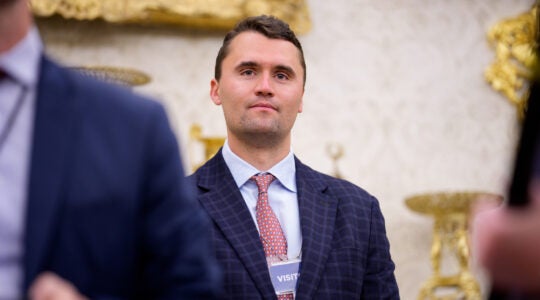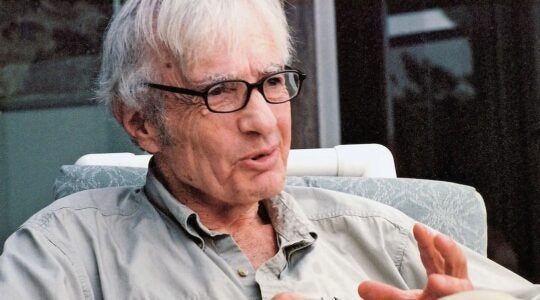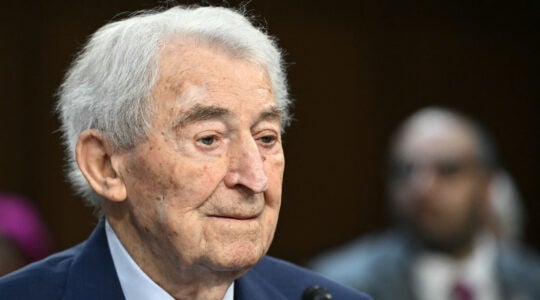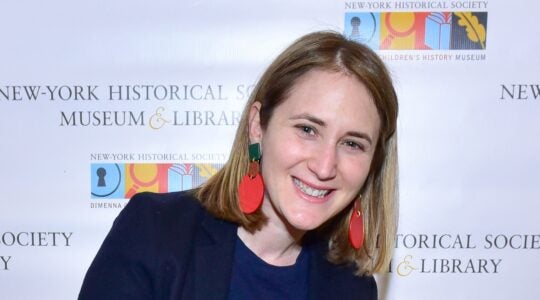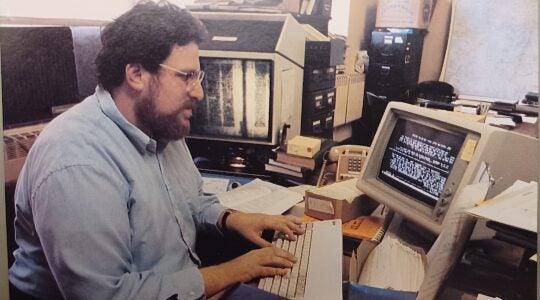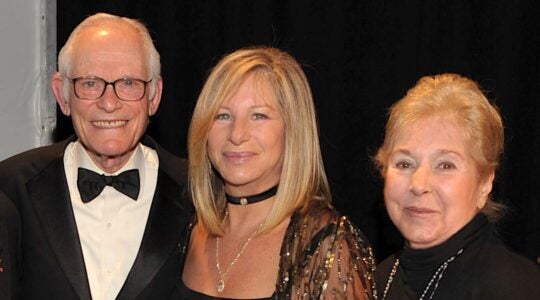
Rabbi Zalman Schachter-Shalomi pioneered groundbreaking ritual innovations that went mainstream. (Daniel Sieradski)
(JTA) — Rabbi Zalman Schachter-Shalomi was one of the world’s most innovative and influential Jewish spiritual leaders.
To his followers, he was their Hasidic rebbe. But what other rebbe had dropped acid with Timothy Leary and dialogued with the Dalai Lama?
Schachter-Shalomi, who died last week at 89, wasn’t the only rabbi who tinkered radically with Jewish tradition. No one else, however, did so with the sense of gravitas and authenticity that came with carrying a living memory of the richness of prewar Jewish Europe.
Though Jewish Renewal, the movement he helped midwife, remains marginal by the standards of the major Jewish denominations, many of the ritual innovations he fostered have long since gone mainstream — from the use of musical instrumentation during services to the incorporation of Eastern meditative practices.
Few Jewish spiritual leaders could match the scope of his erudition, steeped as he was not only in sacred texts and Jewish mysticism but contemporary psychology and Eastern spirituality. He was a Yiddish speaker proficient in the vernacular of modern science and computer technology, an academic capable of creating transformative religious experiences for his followers.
“He was a whole world,” said Rabbi David Ingber, spiritual leader of the Manhattan congregation Romemu and a leading figure among the younger generation of Renewal rabbis. “There was no one like him when he was alive, and now that he’s gone, there will never be anyone like him.”
Born in Poland in 1924 into an Orthodox family with Belzer Hasidic roots, Schachter-Shalomi was raised in Vienna and arrived in the United States in 1941. He was ordained as a Chabad rabbi but strayed far from his Orthodox roots, eventually helping to found a movement that fused the ancient and postmodern into a kind of liberal Hasidism.
Like the Hasidic masters of Europe, Schachter-Shalomi encouraged his followers to seek a direct experience of the divine through practices inspired by the Jewish mystical tradition. He embraced a decidedly liberal ethos, championing equal roles for men and women in religious life, welcoming gays and lesbians, and promoting doctrines like eco-kashrut that integrated contemporary concerns into Jewish practice.
Rabbi Arthur Waskow, founder of the Shalom Center in Philadelphia, which for a time was joined with ALEPH: The Alliance for Jewish Renewal, recalled a moment in 1971 when Schachter-Shalomi was leading a service in Washington and asked permission to separate the men and women.
Mindful of the feminist critique then gaining currency in progressive circles, Waskow objected. Schachter-Shalomi explained he was seeking to create a polarity between masculine and feminine energies and asked if it would be acceptable to keep the genders physically together but separate their voices. Waskow agreed.
“He was clearly a great and knowledgeable teacher — and he listened when a newbie said ‘No!’” Waskow wrote last week in a remembrance. “That made him a real teacher.”
Schachter-Shalomi pioneered ritual innovations that were groundbreaking at the time, including meditation, ecstatic dance and drums and other musical instruments in religious services. He led prayers in the vernacular, reading Torah from a scroll but translating it into English on the fly while maintaining the traditional cantillation — a feat he could carry off with seeming aplomb well into his ninth decade.
Though he lost family members to the Nazis, Schachter-Shalomi believed it was a mistake to attempt a restoration of the Jewish world destroyed by the Holocaust. Instead, he felt that Jewish traditions needed to be renewed, harmonized with new ways of viewing reality that emerged in the 20th century, much in the way theology had to be reordered following Galileo’s demonstration that the earth was not the center of the universe.
Schachter-Shalomi spoke often of a paradigm shift made necessary by worldview-busting events — the moonwalk, Auschwitz and Hiroshima were favored examples — that were so earth-shattering they rendered traditional Jewish modalities irrelevant. He wanted Jews to get over what he called their “triumphalist” sense that they had a monopoly on religious truth in favor of an “organismic” model that saw Judaism as one of many tributaries of the divine river.
He was a believer in a radical ecumenism, fascinated by the ways other traditions “get it on with God.” During the historic Jewish dialogue with the Dalai Lama in 1990, Schachter-Shalomi captivated the Tibetan leader with a a lengthy presentation on kabbalistic cosmology.
Along with the legendary composer Rabbi Shlomo Carlebach, Schachter-Shalomi was among the earliest emissaries dispatched by the Lubavitcher rebbe to do outreach on college campuses. But he drifted from the strictures of Orthodoxy, exploring other mystical traditions and immersing himself deeply in the counterculture. His LSD experience, Schachter-Shalomi said later, had confirmed certain “intimations” he had previously about the nature of the spiritual world.
He was a leading figure in the growth of the Havurah movement, the small prayer groups that emerged in the 1960s and rejected institutionalized synagogue Judaism in favor of home-based worship, presaging the rise of today’s independent minyans.
Schachter-Shalomi married four times and fathered 11 children, including one through a sperm donation to a lesbian rabbi.
An inveterate boundary crosser, he declined to choose between the social justice imperatives and progressive politics of Reform Judaism, the spiritual rigor and devotion of traditional Orthodoxy and the mystical impulses of Hasidism. He wanted all of them.
The other Jewish streams “all had their own truths and languages, but they were partial, and Reb Zalman didn’t want a partial expression of religious life,” Ingber said. “He wanted a holistic expression of religious life.”
In the 1990s, Schachter-Shalomi left Philadelphia, where he had held a teaching post at Temple University, to assume the World Wisdom chair at Naropa University, a Buddhist-inspired liberal arts college in Boulder, Colo. There ensconced as the “Boulder rebbe,” Zalman received scores of visitors in his basement study, many of them seeking inspiration and solace on their own journeys away from Orthodoxy.
In his later years, as Schachter-Shalomi began to relinquish many of the leadership responsibilities of the Renewal movement, he came to focus his declining energies on preparing himself and his followers to face his inevitable death. Schachter-Shalomi was driven by a belief that the existing Jewish toolbox was lacking the instruments to navigate the later stages of life — what he came to call the December years.
In 1997, he co-authored “From Age-ing to Sage-ing,” an attempt to recast the golden years as something other than a period of decline. And in March, journalist Sara Davidson published the book “The December Project,” the product of nearly two years of weekly meetings the two conducted in Boulder.
“The whole teaching that he wanted to impart to people was that you will come to the end at some point, and at that point the work is letting go — letting go of your ties, letting go of your loved ones, letting go of everything,” Davidson said.
Despite his failing health, Schachter-Shalomi continued to teach until the very end. One month before his death, he led a retreat at the Isabella Freedman Jewish Retreat Center in northwestern Connecticut for Shavuot. His appearance there had been an annual event, though he had missed the year before because he was too unwell to travel.
After the holiday, Schachter-Shalomi fell ill with pneumonia and spent a week in a hospital in Hartford, Conn., before being flown back to Boulder, where he died in his sleep on the morning of July 3.
JTA has documented Jewish history in real-time for over a century. Keep our journalism strong by joining us in supporting independent, award-winning reporting.
